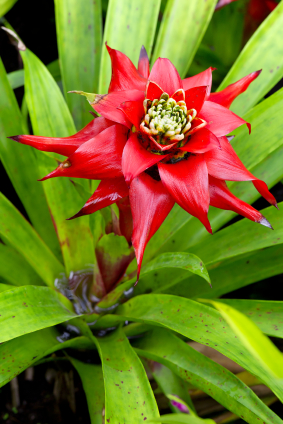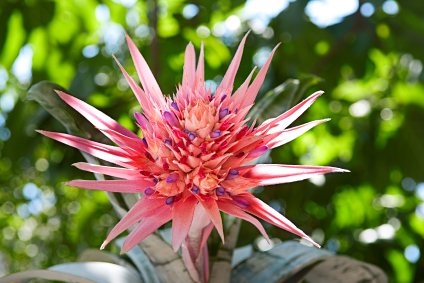Bromeliads for the Holidays
Author: Celeste Booth2 Comments
In much of the United States people expect a white Christmas with snow on the ground. Typical decorations include evergreens and poinsettias. However, in the southern half of the world the holiday season occurs during the summertime. The southern hemisphere, as well as tropical regions of the northern hemisphere, are the native home to many species of bromeliads. If you are looking for a festive and sunny alternative to the typical holiday decoration, bromeliads are perfect.
The Perfect Choice

Guzmania lingulata is a beautiful red bromeliad.
Bromeliads are a great choice for holiday decorating for a number of reasons.
First, some species have green glossy leaves that complement the glitz and glitter of the season’s golds and silvers. Other species have gray or silvery foliage that are striking in a backdrop of evergreen. Many bromeliads also have bright red, festive flower spikes. Those with showy pink flower spikes will also coordinate very well with holiday decorations. Bromeliads are versatile and long lasting making them an excellent option for holiday decorations and gifts.
Bromeliads are also ideal for holiday decoration because they require little maintenance and typically require very little sunlight. Because they have few care concerns, you can place them just about anywhere in an office or home. Many bromeliads also have small root systems that like to be slightly pot bound. This means that small pots can be easily placed in larger decorative pots or containers and clumped with more bromeliads or other festive plants. Bromeliads do not shed needles the way evergreens do so decorating with bromeliads will eliminate the mess often associated with holiday decorations. Bromeliads can also be an ideal replacement for those that suffer from evergreen allergies.
Bromeliad Decorating Ideas
- Consider placing a few small bromeliads in old seasonal tins. Surround the small pots with pearlized decorative rocks or sphagnum moss. Line the bottom of the tin with foil to prevent rust from excess water. Be sure the top dressing covers the foil and any plastic pots.
- Southern Living suggests using a large bowl, tart tin, pie pan, colander or other kitchen container. Place a few bromeliads in the center and then surrounding them with festive fruit such as persimmons and pomegranates. Gourds, apples and oranges will all work as well.
- If you are an interior landscaper consider creating a festive wall design. Because many bromeliads do not require soil, they can be used to make a living and green wall. Pair green foliage plants with red or white variegate plants to create a festive design in a large space such as a foyer, reception area or even a long hallway.
- Tillandsias are air plants that can easily be hung. Use tiny silvery Tillandsias inside a hanging glass globe or simply attached to some twine to hang on a Christmas tree. Globes, with small holes for air circulation and misting, can be purchased from vendors online. Some kits can be purchased with the plants already arranged and others come empty so that you can choose your own plants. Door and window frames are also fun places to hang festive Tillandsia ornaments. Tillandsias can also be incorporated on holiday wreathes using dusty green firs as a base and pairing them with colorful berries. Woven vines also make a good palette for a Tillandsia wreath.
- Use bromeliads as embellishments for packages. Tie small plants in with large bows to add living decoration to your gifts. Small potted bromeliads or mounted air plants work well for this.
- If your holiday party host doesn’t enjoy wine and you brought candles as gifts the last three years consider bringing an easy-to-care-for bromeliad. A bromeliad with briliant red bracts such as a Guzmania lingulata will be a highlight in any holiday party and can be enjoyed by your host for months to come.
- Place large, colorful bromeliads in glossy red, white or silver containers. Dress the tops of containers with scattered ornaments over artificial snow or dress the top of the container using small, shiny glass orb ornaments.
- Create a bromeliad tree. To achieve this look, simply stack pots of green foliage bromeliads in tiered tree shapes interspersing bromeliads with red bracts for variation. These bromeliad trees can make a small table top decoration or an extravagant life size tree.
Finding the Right Species

The Aechmea fasciata is another great choice for the holidays.
Many species of bromeliads are commonly sold in nurseries and garden centers. Guzmania, Vrieseas and Aechmea are three of the most commonly sold bromeliad genera. If you are looking for a more specialized or unique bromeliad you may have to find a specialty bromeliad retailer online. This Essential Bromeliad Buyers Guide has a few tips about where to start. Listed below are a few species and cultivars of bromeliads that will make excellent holiday decorations.
There are several Guzmania that will make ideal holiday bromeliads. Guzmania ‘Pax’ and Guzmania ‘Snowball’ are two cultivars that have bright white bracts with deep green foliage. Bromeliads with white flower bracts are not used as often when creating indoor arrangements, but these cultivars will sparkle as a holiday decoration. Guzmania ‘Luna’ is a large cultivar with deep red inflorescence. Many other Guzmania also have varying shades of red inflorescence.
Aechmea fasciata is an easy to find bromeliad that has dusty silver banded leaves and a showy pink flower spike with small purple flowers. This is a large centerpiece plant.
Vriesea splendens is also a large plant with a brilliant red flower spike. The foliage is beautifully banded with a chocolate color.
Foliage Plants
Neorogelia ‘First Prize’ is an attractive foliage plant with deep red foliage toward the center of the plant. The red foliage is also speckled with bright green. Many Neorogelias offer beautiful foliage in both form and color.
Dyckias also offer unique foliage in a small plant. Most Dyckias have sharp jagged margins around their leaves giving them a sort of star like appearance. The leaves usually form compact rosettes that curve down over the top of one another. Many Dyckia also have a silvery hue to their foliage. Some popular cultivars of Dyckia that will make wonderful compact holiday decorations include Dyckia ‘Snowball,’ Dyckia ‘Red Devil’ (with red foliage) and Dyckia ‘Brittle Star’
Tillandsia albida is a small air plant with silvery white leaves and a simple red flower spike. It would be ideal for mounting or hanging from a string as an ornament. Tillandsia ionatha is also well suited to mounting on wreathes.
The Gift that Keeps Giving
Bromeliads will continue to thrive long after the holiday season has ended. They will also produce offspring called pups once the flower is spent and the plant begins to die. These pups will mature and produce more pups. As long as the plant is taken care of, a bromeliad is literally the gift that keeps giving year after year.
Do you have any fun holiday bromeliad decorating ideas? Have you ever given or received a bromeliad as a gift?
Sources
Air Plant City. <http://airplantcity.com>
“Dyckia” Bromeliad Society/Houston. <http://bromeliadsocietyhouston.org/genera-intro/dyckia/>
Florida Council of Bromeliad Societies Bromeliad Photo Index <http://fcbs.org/pictures.htm>
Kents Bromeliad Nursery Inc. <http://www.kentsbromeliad.com/whatsnew-2.php>
Ruoff Riley, Ellen. “Bromeliads: the “Holiday Centerpiece” Flower to Try” Southern Living. <http://www.southernliving.com/home-garden/gardens/bromeliads-holiday-centerpiece-flower-try-00400000010388/page3.html>
“The Web Shop” Flora Grubb Gardens. <http://shop.floragrubb.com>
Tropiflora. <http://tropiflora.safenetserver.com>
2 Responses to “Bromeliads for the Holidays”
Leave a Reply

Resource Download
Hechtia Care Cheat Sheet
Learn how to care for your Hechtia bromeliad with this quick and easy informational guide.
Learn More
Ask an Expert
Questions about bromeliads?
Our experts love a challenge!
Photo of the Week
Submit your photo to be featured on the blog!
More Photo of the Week Winners
Submit Photo








It looks like the plant is dead the center color part of the plant is brown instead of red but the leaves are still green. What do I do about this?
Once your bromeliad has finished bloooming, it will put its energy into producing pups (new bromeliad plants). This is perfectly normal and you can remove the browning flower if you want.